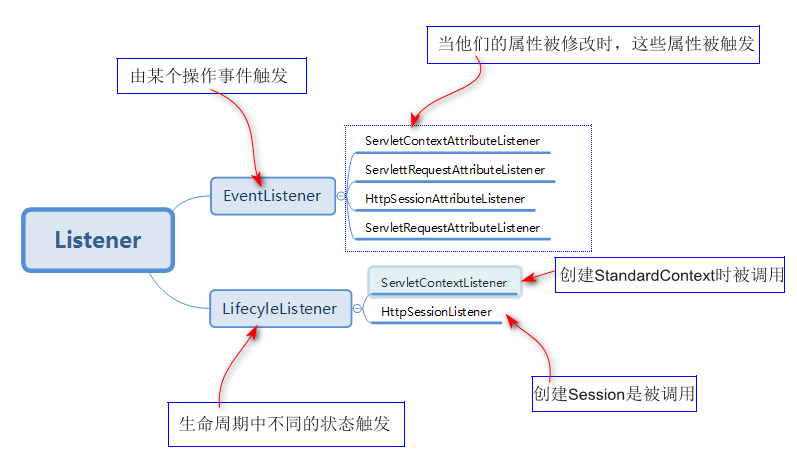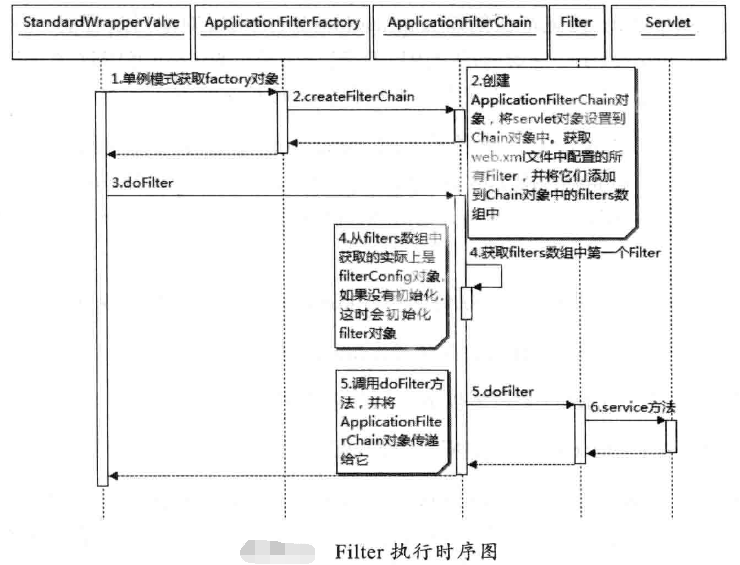[web]Servlet中的Listener和Filter
建议先看看 ——> Servlet工作原理
一、Listener
在Tomcat服务中,Listener的设计是基于观察者模式的,目前在Servlet中提供6中两类事件的观察者接口,它们分别是:
实际上这六个Listener都继承了EvenListener,每个Listener由分别定义了自己需要实现的接口:
ServletContextAttributeListener:

public interface ServletContextAttributeListener extends EventListener { // 设置属性时 public default void attributeAdded(ServletContextAttributeEvent scae) { } // 删除属性时 public default void attributeRemoved(ServletContextAttributeEvent scae) { } // 、更改属性时 public default void attributeReplaced(ServletContextAttributeEvent scae) { } }
ServletRequestAttributeListener:

public interface ServletRequestAttributeListener extends EventListener { // 更改Request属性时 public default void attributeAdded(ServletRequestAttributeEvent srae) { } // 更改Request属性时 public default void attributeRemoved(ServletRequestAttributeEvent srae) { } // 更改Request属性时 public default void attributeReplaced(ServletRequestAttributeEvent srae) { } }
HttpSessionAttributeListener:

public interface HttpSessionAttributeListener extends EventListener { // 添加 Session 属性时 public default void attributeAdded(HttpSessionBindingEvent se) { } // 删除 Session 属性时 public default void attributeRemoved(HttpSessionBindingEvent se) { } // 更改 Session 属性时 public default void attributeReplaced(HttpSessionBindingEvent se) { } }
ServletRequestAttributeListener:

public interface ServletRequestAttributeListener extends EventListener { public default void attributeAdded(ServletRequestAttributeEvent srae) { } public default void attributeRemoved(ServletRequestAttributeEvent srae) { } public default void attributeReplaced(ServletRequestAttributeEvent srae) { } }
ServletContextListener:

public interface ServletContextListener extends EventListener { // StandardConetxt 创建时 public default void contextInitialized(ServletContextEvent sce) { } // StandardConetxt 销毁时 public default void contextDestroyed(ServletContextEvent sce) { } }
HttpSessionListener:

public interface HttpSessionListener extends EventListener { public default void sessionCreated(HttpSessionEvent se) { } public default void sessionDestroyed(HttpSessionEvent se) { } }
二、Filter
Filter可以完成和Servlet同样的工作,除了request和response两个对象外,它还提供了一个FilterChain对象,它可以帮助我们更加灵活地控制请求的流程,该接口定义如下:
Filter:

public interface Filter { // 初始化接口,在用户定义的Filter初始化时被调用,它与Servlet的init方法是一样的, // FilterConfig也和ServletConfig类似,除了可以获取ServletContext之外,还可以在配置文件中声明参数 public default void init(FilterConfig filterConfig) throws ServletException {} // 每个用户的匹配请求进来时,这个方法都被调用,并且是在Servlet的service方法之前被调用, // 而 FilterChain代表了当前的整个请求链,通过调用FilterChain.doFilter可以将请求继续传递下去, // 如果需要拦截该请求,那么就不调用FilterChain,就可以直接返回了,所以它是一种责任链模式 public void doFilter(ServletRequest request, ServletResponse response, FilterChain chain) throws IOException, ServletException; // Filter被销毁时,会调用这个方法,web容器调用这个方法之后,容器会再调用一次doFilter方法 public default void destroy() {} }

除此之外还有两个接口的定义,分别FilterConfig 和FilterChain
FilterConfig:

public interface FilterConfig { /** * Get the name of the filter. * */ public String getFilterName(); /** * Returns a reference to the {@link ServletContext} in which the caller is * executing. * */ public ServletContext getServletContext(); /** * Returns a <code>String</code> containing the value of the named * initialization parameter, or <code>null</code> if the parameter does not * exist. * */ public String getInitParameter(String name); /** * Returns the names of the filter's initialization parameters as an */ public Enumeration<String> getInitParameterNames(); }
FilterChain:

public interface FilterChain { /** * Causes the next filter in the chain to be invoked, or if the calling * filter is the last filter in the chain, causes the resource at the end of * the chain to be invoked. * */ public void doFilter(ServletRequest request, ServletResponse response) throws IOException, ServletException; }
三、<url-pattern>匹配规则
-
- 精确匹配:如/foo/.html,只能匹配/foo.html
- 路径匹配:如/foo/*,将匹配/foo/路径下所有的URL
- 后缀匹配:如*.html,将匹配所有所有的后缀为.html的路径
匹配的顺序也是:精确匹配——> 最长路径匹配——>后缀匹配





